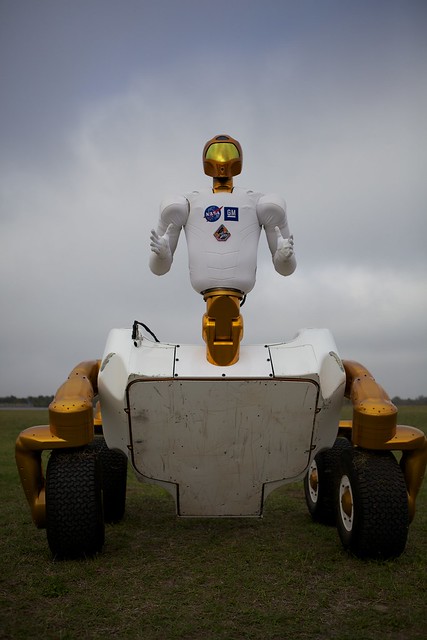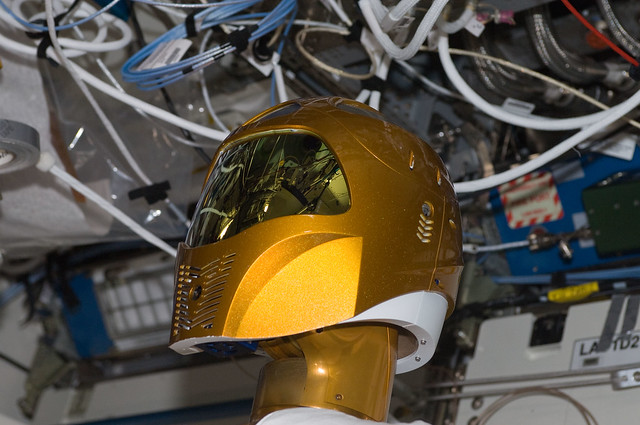Robonaut 2 launched up to the ISS on February 24th, 2011, fulfilling a 15 year dream to put a humanoid robot into space.
Nearly 50 individual technologies available for licensing
Mobility
Researchers at NASA's Johnson Space Center (JSC), in collaboration with General Motors and Oceaneering, have designed a state-of-the-art, highly dexterous, humanoid robot: Robonaut 2 (R2). R2 is made up of multiple component technologies and systems -- vision systems, image recognition systems, sensor integrations, tendon hands, control algorithms, and much more. R2's nearly 50 patented and patent-pending technologies have the potential to be game-changers in multiple industries, including logistics and distribution, medical and industrial robotics, and beyond.
NASA JSC has developed a series of Centaur rovers to carry the Robonaut upper bodies and other payloads. Centaur 1 was developed for work with the Robonaut R1B humanoid upper torso in 2006. Centaur 2 rover was developed in 2010 by the Human Robotics Systems (HRS) Project as part of the Exploration Technology Development and Demonstration Programs, and has now been integrated with the Robonaut R2A torso. This combination mixes state-of-the-art robotic mobility with the world’s most advanced dexterous manipulation system. Hybrid rover/arm systems, commonly referred to as mobile manipulation, represent a new domain of robotics research. Mobile manipulation is an important new Space Technology with multiple applications for improving life here on Earth. NASA’s new Centaur2/Robonaut2 system is an ideal testbed for this research and positions the agency as the technological leader.
Researchers at NASA's Johnson Space Center (JSC), in collaboration with General Motors and Oceaneering, have designed a state-of-the-art, highly dexterous, humanoid robot: Robonaut 2 (R2). R2 is made up of multiple component technologies and systems -- vision systems, image recognition systems, sensor integrations, tendon hands, control algorithms, and much more. R2's nearly 50 patented and patent-pending technologies have the potential to be game-changers in multiple industries, including logistics and distribution, medical and industrial robotics, and beyond.
What is a Robonaut?
A Robonaut is a dexterous humanoid robot built and designed at NASA Johnson Space Center in Houston, Texas. Our challenge is to build machines that can help humans work and explore in space. Working side by side with humans, or going where the risks are too great for people, Robonauts will expand our ability for construction and discovery. Central to that effort is a capability we call dexterous manipulation, embodied by an ability to use one's hand to do work, and our challenge has been to build machines with dexterity that exceeds that of a suited astronaut.
There are currently four Robonauts, with others currently in development. This allows us to study various types of mobility, control methods, and task applications. The value of a humanoid over other
designs is the ability to use the same workspace and tools - not only does this improve efficiency in the types of tools, but also removes the need for specialized robotic connectors. Robonauts are essential to NASA's future as we go beyond low earth orbit and continue to explore the vast wonder that is space.
Robonaut 2 or R2, launched to the International Space Station on space shuttle Discovery as part of the STS-133 mission, it is the first dexterous humanoid robot in space, and the first US-built robot at the space station. But that was just one small step for a robot and one giant leap for robot-kind.
Initially R2 will be deployed on a fixed pedestal inside the ISS. Next steps include a leg for climbing through the corridors of the Space Station, upgrades for R2 to go outside into the vacuum of space, and then future lower bodies like legs and wheels to propel the R2 across Lunar and Martian terrain. A four wheeled rover called Centaur 2 is being evaluated at the 2010 Desert Field Test in Arizona as an example of these future lower bodies for R2.
In the current iteration of Robonaut, Robonaut 2 or R2, NASA and General Motors are working together with assistance from Oceaneering Space Systems engineers to accelerate development of the next generation of robots and related technologies for use in
the automotive and aerospace industries. Robonaut 2 (R2) is a state of the art highly dexterous anthropomorphic robot. Like its predecessor Robonaut 1 (R1), R2 is capable of handling a wide range of EVA tools and interfaces, but R2 is a significant advancement over its predecessor. R2 is capable of speeds more than four times faster than R1, is more compact, is more dexterous, and includes a deeper and wider range of sensing. Advanced technology spans the entire R2 system and includes: optimized overlapping dual arm dexterous workspace, series elastic joint technology, extended finger and thumb travel, miniaturized 6-axis load cells, redundant force sensing, ultra-high speed joint controllers, extreme neck travel, and high resolution camera and IR systems. The dexterity of R2 allows it to use the same tools that astronauts currently use and removes the need for specialized tools just for robots.

One advantage of a humanoid design is that Robonaut can take over simple, repetitive, or especially dangerous tasks on places such as the International Space Station. Because R2 is approaching human dexterity, tasks such as changing out an air filter can be performed without modifications to the existing design.
Another way this might be beneficial is during a robotic precursor mission. R2 would bring one set of tools for the precursor mission, such as setup and geologic investigation. Not only does this improve efficiency in the types of tools, but also removes the need for specialized robotic connectors. Future missions could then supply a new set of tools and use the existing tools already on location.
The project is led by the Robotics Systems Technology Branchin the Software Robotics and Simulation Division at Johnson Space Center's Engineering Directorate.
http://robonaut.jsc.nasa.gov
http://robonaut.jsc.nasa.gov



No hay comentarios:
Publicar un comentario